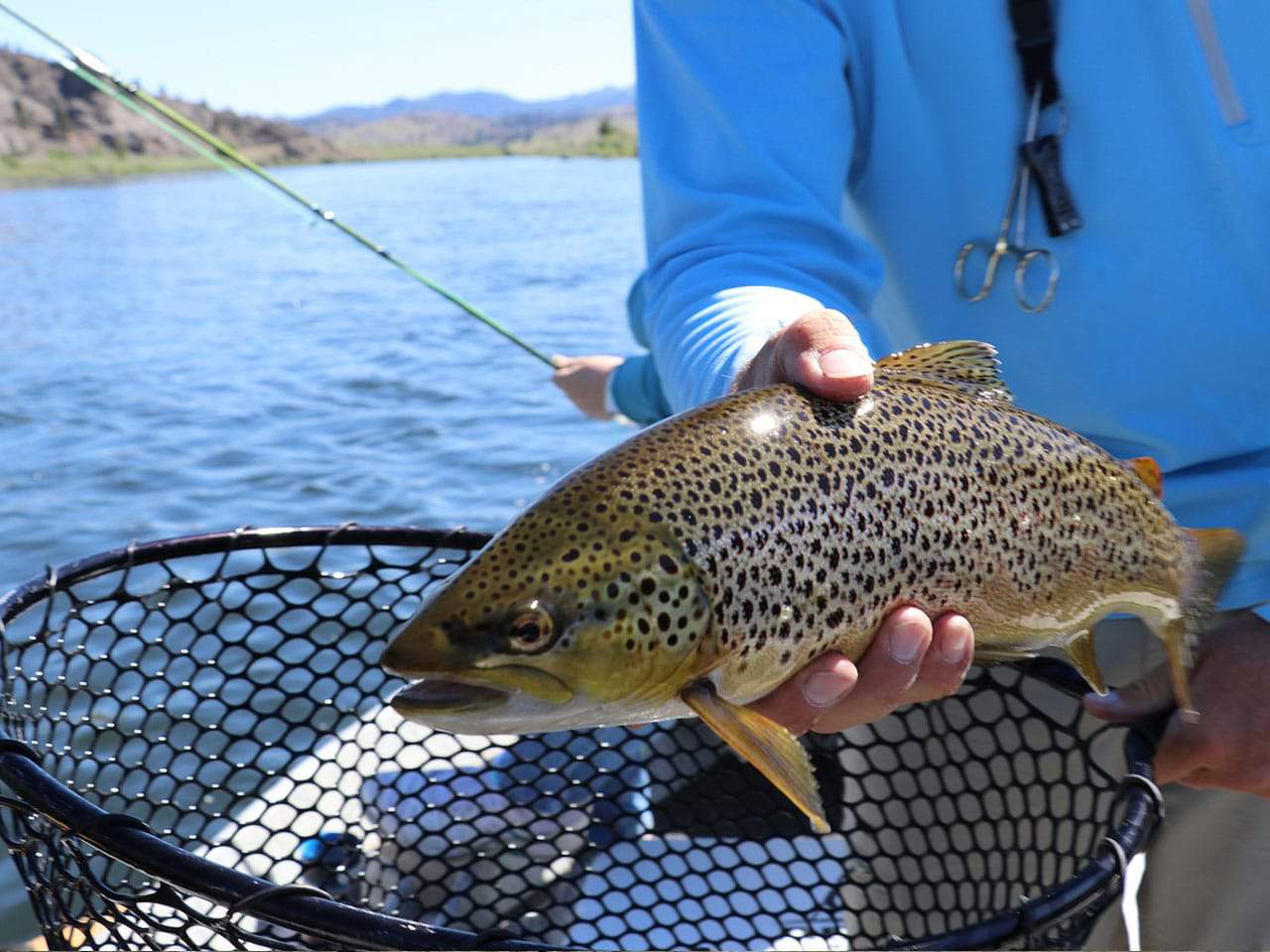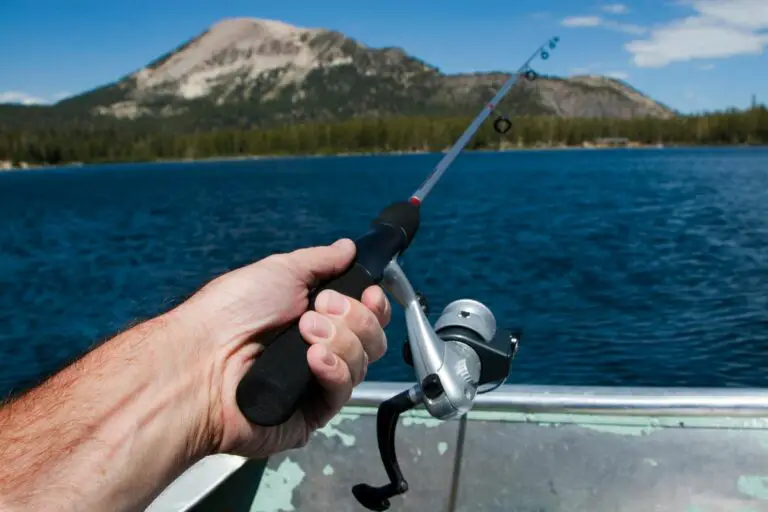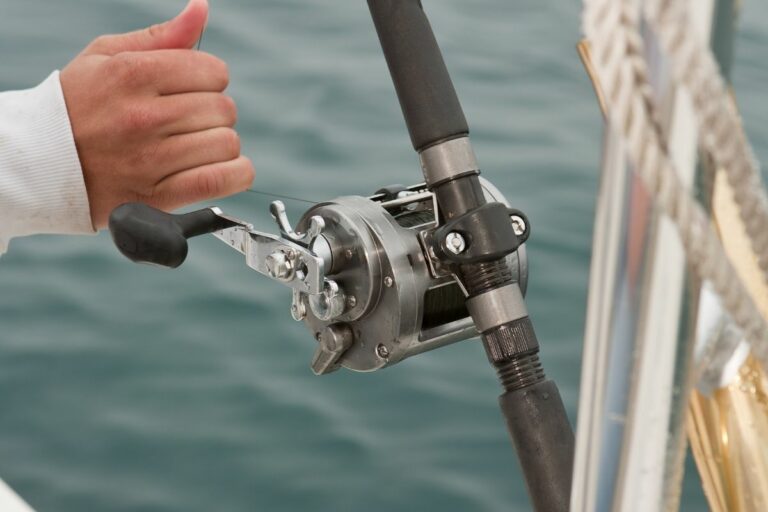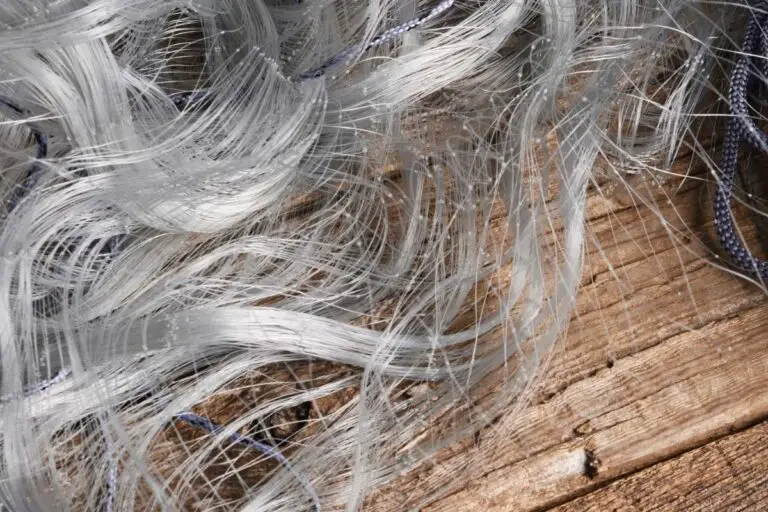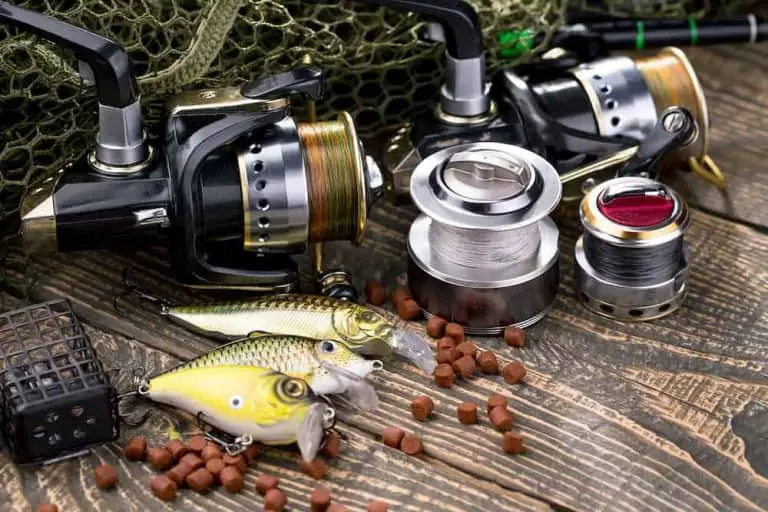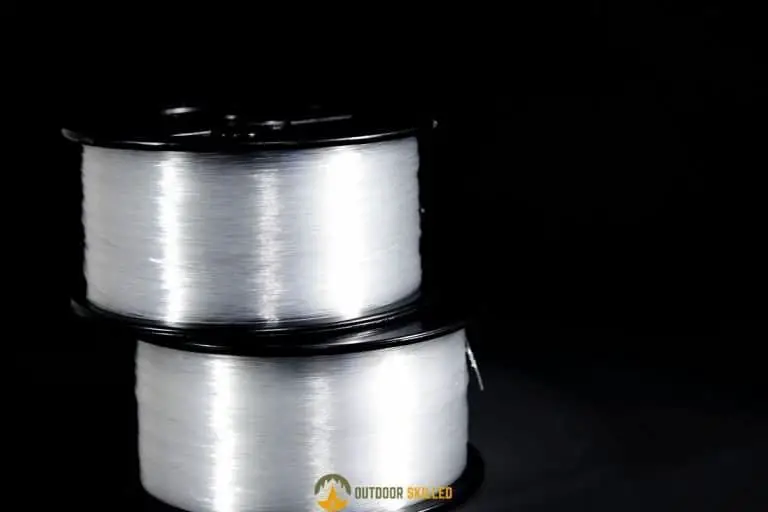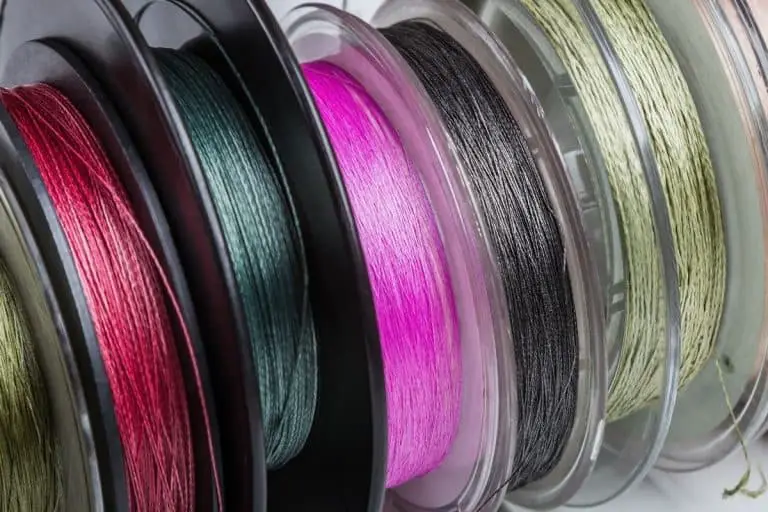The 6 Best Trout Fishing Lines that Always Perform
Fishing lines designed for trouts are abundant, but not all of them are that good.
But what makes trout fishing such a popular activity anyway? Trouts can be found everywhere, which encourages beginners and pros to try and catch trout. Also, they’re a bit shy and feisty, and that makes catching them even more challenging and fun.
However, you have to know what your fishing needs are to know which line is best for you. So, without further ado, here is everything you need to know about trout fishing and the best trout fishing lines.
Table of Contents
List of the Best Trout Fishing Lines:
- Berkley Vanish – Best 2LB Fluorocarbon Line for Trout
- Berkley XL906-15 – Best 2LB Monofilament Fishing Line for Trout
- KastKing SuperPower – Best Braided Fishing Line for Trout
- KastKing FluoroKote – Best Budget Line for Trout
- Piscifun Sword – Best Fly Fishing Line for Trout
- Sufix Performance – Best Lead Core Line for Trout
The 6 Best Trout Fishing Lines in 2021
1. Berkley Vanish – Best 2LB Fluorocarbon Line for Trout

The Berkley Vanish is, well, for those who’d like their lines to vanish at a very affordable price for a fluorocarbon. Before we get into that, let’s start with the pound test and length.
It comes in pound tests ranging from 2 to 60 lb. So, not only will you use it to catch trouts, but also for a seriously wide range of freshwater, or even saltwater, fish. In terms of strength, it comes in 110 to 2000 yards.
The thin diameter this line has helps you cast very smoothly and easily.
If there’s one thing this line prides itself on, it’s being 100% fluorocarbon. As its name suggests, this is the line to use when any other line is seen in similar circumstances. Its pure fluorocarbon construction gives it excellent abrasion resistance.
Because it tends to have memory, it is best used as a leader to avoid dealing with potential twists or curls.
Pros:
- Affordable
- Impressive pound tests from 2 to 60 lb
- 110 to 1700 yd
- 100% fluorocarbon
- Excellent abrasion resistance
- Thin diameter with great castability
- Good for saltwater and freshwater
Cons:
- Has memory
Bottom Line
If you’re fishing where you really need to hide your line from trouts, there’s no better option than the Berkley Vanish.
2. Berkley XL906-15 – Best 2LB Monofilament Fishing Line for Trout

Some people want to have light tackle, while others are going after the big boys. The pound test can go from as light as 2 pounds to as high as 30. The Berkley XL is here to impress with line length ranging from 110 to 9000 yards.
If there’s one thing you need this line for, it is its smooth casting, thanks to its smooth and round construction. It works great with spinning reels.
Mono is a flexible line in itself, but the Berkley XL is 20% even more flexible than competitors. It also has a 20% greater knot strength. This is a line that will work wonderfully for beginners because the flexibility and knot strength make it much easier to use.
Other monofilament lines disappoint when it comes to strength when wet. However, the Berkley XL has a 50% greater wet strength than competitors. It also has great abrasion resistance against the tough structures your target trout will likely hide under.
Pros:
- 2 to 30 lb
- Impressive line length from 110 to 9000 yd
- Low memory
- 50% greater wet strength
- 20% greater knot strength
- 20% more flexible than competitors
- Great castability
- High abrasion resistance
- Good for saltwater and freshwater
- 3 color options
Cons:
- Low sensitivity
Bottom Line
The Berkley XL offers you what every good mono does and more such as in wet strength, knot strength, and flexibility.
3. KastKing SuperPower – Best Braided Fishing Line for Trout

The KastKing SuperPower is no joke among braided lines. With a pound test range from 6 to 150 pounds, you can use this line to catch anything from the average-sized trouts to blue catfish. It comes in 327, 547, and 1097 yards to match its wide pound test range.
As an excellent braided line does, the KastKing SuperPower has an incredibly thin diameter for improved casting distance and more line capacity. Moreover, it comes with an impressive selection of color options.
In addition, it has a 4-strand design for lighter tests and even more powerful 8-strand designs for heavier ones. This design gives the line unparalleled abrasion resistance, which is needed when you’re going after fish like trout.
Another advantage this line offers you is its ultra-high sensitivity and lack of stretch, an essential quality for when smaller trouts think they’re being sneaky or when you need some serious hook setting powers.
Pros:
- Impressive pound tests from 6 to 150 lbs
- Comes in 327/547/1097 yd
- Impressive selection of color options
- Ultra-high sensitivity
- High abrasion resistance
- Thinner diameter
- Excellent hook setting
- Low memory
- High knot strength
Cons:
- Colors fade despite fade-resistance claim
Bottom Line
With the sensitivity and strength it offers to the table, the KastKing SuperPower is one of the best trout fishing lines.
I also have another guide on the best braided fishing lines here that you will definitely find useful.
4. KastKing FluoroKote – Best Budget Line for Trout

The fact that fluorocarbon is the ideal choice for trout fishing is well-known, but are there cheaper options that aren’t mono? Well, KastKing has heard you loud and clear and gave you the KastKing FluoroKote: a copolymer line with 100% fluorocarbon coating.
This miracle line, at a price more affordable than fluorocarbon, comes in 300 yards and pound tests from 4 to 30 pounds. You’ll get your money’s worth in these pound tests because the line lives up to its claim in terms of strength and abrasion resistance.
The idea of combining copolymer with fluorocarbon is genius because you won’t need to use a leader, and the line is already very affordable. Now you have fluorocarbon’s absolute invisibility to trouts with the smooth castability and low memory of copolymer.
In addition, this line has a diameter thinner than the KastKing copolymer lines and other mono, giving you higher line capacity and bigger casting distance.
Finally, this line has a fast sinking rate to help you catch the trouts that lurk at the bottom, which means it won’t work for under-the-surface fishing.
Pros:
- Affordable alternative to fluorocarbon
- 100% fluorocarbon coating for invisibility
- 4 to 30 lb
- Fast sinking
- High sensitivity
- Great knot strength
- Copolymer for superior castability
- Great abrasion resistance
- Low memory
- Thin diameter
Cons:
- Won’t work for surface fishing
Bottom Line
The KastKing FluoroKote combines the invisibility of fluorocarbon and the low memory of copolymer at a very affordable price. Unless you’re going for topwater fishing, it doesn’t get any better than this.
5. Piscifun Sword – Best Fly Fishing Line for Trout

Fly fishing is one of the most popular ways to get trouts, and this line should be your first choice to fly fish for trouts.
The Piscifun Sword comes in lengths of 90 and 100 feet. Its weight ranges from 1 to 10 F, or weights, which covers the smallest trouts in tiny streams up to the largest ones in saltwater surrounded by the roughest structures.
As a weight-forward fly line, it has a longer head and bigger diameter, helping its longer casts flow smoothly through the guides. Also, it has a welded loop to facilitate leader attachments.
In addition, it has a braided core to keep its memory low in all weather conditions and to make it highly sensitive towards any action.
We can’t help but mention its variety of color options. It has 7 colors that cater to your high-viz and low-viz needs. Also, the spool is degradable to help ease your consciousness about your environmental impact.
Pros:
- WF for superior casting
- 90 and 100 ft
- 1 to 10 F
- 7 color options
- Braided core flow lower memory
- Suitable for beginners
- Welded loop for easy leader attachment
- Degradable spool
Cons:
- Double loops could make it better
Bottom Line
If you want an affordable fly line for trouts with excellent castability and low memory, look no further.
6. Sufix Performance – Best Lead Core Line for Trout

Lead core lines can work wonders for catching trouts. However, these aren’t lines you give your beginner cousins to help them start their trout fishing journey. These are lines you use knowing you can handle the heaviness of something with high-density lead as a core.
The Sufix Performance comes in 100 yards and pound tests ranging from 12 to 36 pounds. These specs establish the line as one made for trolling, not light surface fishing, to catch small trouts.
We love the Sufix Performance’s lack of stretch because it means higher sensitivity. Also, the impressive knot strength and tensile strength aren’t surprising when you realize this line is made of 100% HMPE Dyneema fibers.
Like any good lead core line, the Sufix Performance is metered, with a different color for every 10 yards. This quality is essential for trolling because that’s when you need to monitor your depth the most. You only succeed in trolling when you know where you are.
Pros:
- Ultra-fine diameter
- Excellent sinking speed.
- Great knot strength
- Great tensile strength
- High sensitivity
Cons:
- Frays if you’re not careful
Bottom Line
If you’re looking for a line for your trolling and deep fishing needs, there’s nothing better than the Sufix Performance.
What to Look for When Buying a Fishing Line for Trout
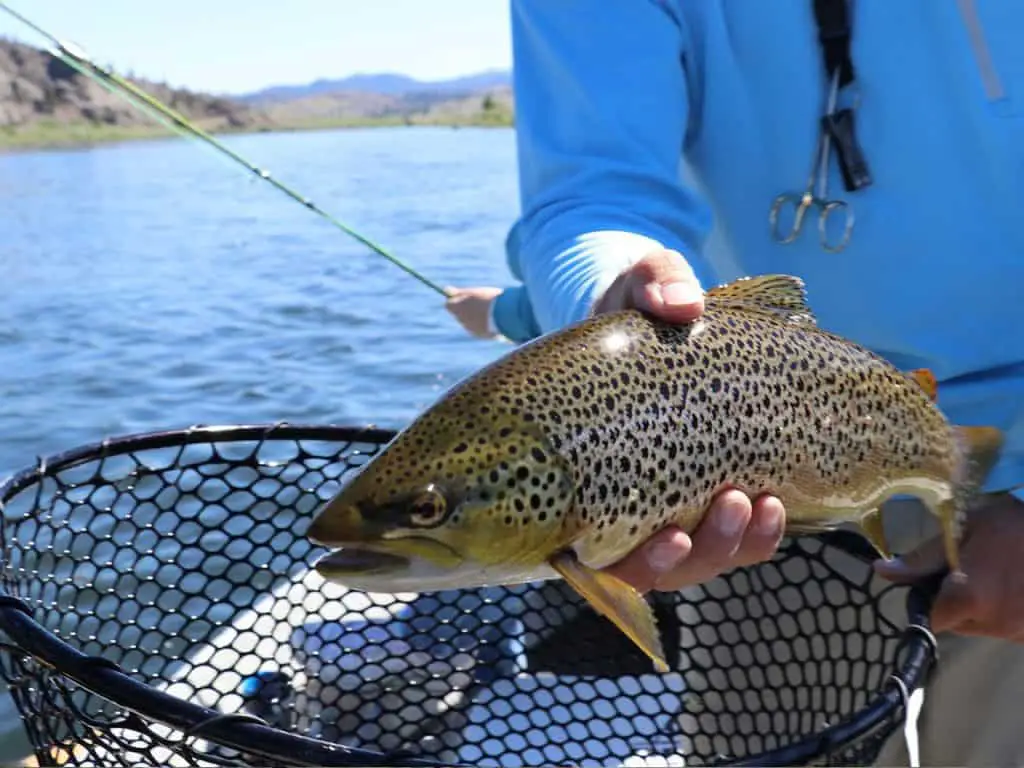
1. Type
Fluorocarbon
Fluorocarbon is the most popular and sensible option for trout fishing because its qualities match with trout’s nature. Trouts are really shy, and they usually exist in freshwater, so using a line with the lowest visibility makes perfect sense. It is basically invisible underwater.
Also, fluorocarbon has high sensitivity due to the lack of stretch, which means that you’ll feel the slight movements and the light bites of these shy trouts that really don’t want you to find them.
Another thing to note about fluorocarbon is that it sinks, and that is a useful quality in hot weather because trouts tend to hide deep down to escape the heat, so a fluorocarbon line will make sure you get your bait down where it’s needed.
One thing that aids fluorocarbon in its deep fishing is its thin diameter, which increases the casting distance, whether long or deep.
I have a guide on the best Fluorocarbon lines here that is worth checking out.
Monofilament
Mono is a popular choice because it’s affordable. Also, it’s stretchy and flexible, which means it’s the easiest fishing line to use.
The flexibility also means better shock absorption and fewer line breaks if a trout attacks suddenly. Mono’s abrasion resistance is amazing, thanks to its bigger diameter, for when trouts hide under brush piles, weeds beds, or logjams.
You also need to know that mono tends to stay under the surface and doesn’t sink much. A quality like this is beneficial when you’re using topwater baits, and you don’t want fluorocarbon to weigh them down. A good application for mono would be fly fishing.
I have another guide on the best Monofilament lines here that is also worth checking out.
Braided
Because of trout’s shyness, braids tend to be a much less popular option. However, they have their good points that may help you score if you know how to utilize them.
Braided lines have the thinnest diameters, so their casting distance is impressive.
In addition, they have the highest sensitivity due to the lack of stretch, so there isn’t a trout too-sneaky for you now.
These woven-fiber lines offer excellent abrasion resistance to help pull your trouts out of the heaviest covers. Also, they have the highest pound tests, for when you’re going after the big boys.
We can’t deny how inconvenient a braid’s visibility is; however, you can combine it with a fluorocarbon leader to reduce its visibility underwater.
Lead Core
This line isn’t for your usual freshwater trout fishing. A hardcore line like this is meant for deep-sea fishing and trolling at an affordable price. Why?
Because its lead core gives it a high density, making it heavy and sturdy. It is also good for lightweight baits because it can weigh them down for you quickly.
The best thing about a lead-core line, besides its price, is its color metering. Usually, with a different color every 10 yards, this metered system let’s you know where the line is in terms of depth.
Still not sure which line to choose? Check out these comparisons:
- The Braided VS Fluorocarbon lines here
- The Braided VS Monofilament lines comparison
- The Monofilament vs Fluorocarbon lines comparison here.
2. Color
Line colors dramatically affect your trout fishing experience.
Bright colors should only be used at night to help you see and monitor the line. They are also useful if you’re using more than one line and you’d like to tell which is which.
Low-viz colors help camouflage the line from the easily-spooked trouts in tinted waters and heavy covers.
If you’re not sure, a clear fluorocarbon is good to go at all times, but especially in clear waters or on sunny days when you’re trying to catch some brown trouts.
You can learn how color affects trout fishing here in much more detail. I also discuss how to choose the right bait, line, and lure color in every trout-fishing situation you can think of.
3. Strength or Weight
Line strength is understood in terms of how much weight an unknotted line can carry or how much pressure it can handle before its breaking point. Usually, it is in pounds and is called a pound test.
A line in pounds should more or less match your target fish in order not to break. For a big majority of trouts, a 4-pound mono or fluorocarbon line is sufficient. If you’re targeting bigger trouts, go higher in pounds.
If we’re talking about fly fishing, line strength is measured in grains or weights. You can catch the smallest trouts with lines ranging from 1 to 3 weights. Lines from 4 to 6 weights pretty much cover all trouts, so you don’t have to go higher unless you’ll use that line for other fish.
4. Memory
Line memory refers to its tendency to “remember” its last position, like how it curls and tangles when it’s left for too long on the spool. The higher the memory is, the harder it would be to cast or use with spinning reels.
There are hacks to deal with this issue.
One popular hack is placing the spool in hot water to loosen up the line, especially if it’s mono. Other anglers gently stretch out the line for a few minutes to remove the memory. Using a line conditioner is also very productive.
However, the most important thing to do is to spool your line correctly.
Keep your eyes on lines that come with technologies, treatments, or coatings to reduce memory.
5. Diameter
The size of the diameter can make or break your fishing experience, depending on what you’re looking for.
Thinner diameters are usually found in braided and fluorocarbon lines. They help you have more line capacity on the spool, which is very economical despite the price. In addition, they give you a larger casting distance, which is helpful in catching trout.
Does that mean bigger diameters, like in mono, are a bad thing? Not necessarily. Bigger diameters have impressive strength and abrasion resistance, and they tend to be tougher than thinner diameters.
However, they’re more suitable for surface fishing, as they won’t cast that far or deep.
Frequently Asked Questions:
Is a Braided Line Good for Trout Fishing?
It can be if we overlook the visibility issue. Braided lines are visible and unnatural looking underwater, which can be problematic when dealing with shy fish like trouts. However, you can solve this visibility issue by combining it with a fluorocarbon leader.
Braided lines have the excellent abrasion resistance and quick hook setting powers that can be quite helpful in catching trout. We can’t complain about its smooth castability either.
What Is the Best Line Weight for Trout Fishing?
The most common choices for line weights are 4 to 6 pounds in mono or fluorocarbon. Lines with a weight from 1 to 4 work great with small trouts, while lines weighing more than 6 to up to 30 pounds target larger trouts.
You can change that depending on the kind of trout you’re after and how rough the environment you’ll fish in is.
What Line Size Should I Use for Trout?
Average fishing reels can handle 150-250 yards of line, so use that to your advantage in spooling the main line and leader. Many anglers use cheap filler lines to get to the length recommended by the reel.
Remember not to under or overfill the spool. Underfilling leads to too much friction, which will negatively affect your casting distance while overfilling leads to curls and twists that no one wants to deal with.
Also, the thicker the diameter, the less line you’ll be able to spool.
What Is the Best Trout Fly Line?
The best trout fly line is the Piscifun Sword. It has everything you need for trout fly fishing. Its weight ranges from 1 to 10 weights, which is all you need for the smallest trouts to the largest ones. It’s a weight-forward fly line, which gives you the longest and smoothest casts.
Of course, we must mention its braided core, which increases sensitivity and reduces memory. High sensitivity and low memory make fly fishing a dream.
Also, it comes in 7 different colors to offer you something for every scenario.
What Line Color Is Best for Trout Fishing?
Without a doubt, the best color choice for trout fishing is clear or translucent.
Trouts are very shy, and they have the best vision in fish that usually live in clear freshwater, so your options may be limited.
Your best shot at translucency is fluorocarbon. Your next best options are low-viz greens and browns to use with tinted water. You can use high-viz colors to guide you in fly fishing.
Final Thoughts
There are many manufacturers that claim that their lines are the best for trout fishing, but you need to look elsewhere after checking out the lines on our list.
If you’re looking for a line to go after the big trout, consider the Berkley Vanish, KastKing SuperPower, and Piscifun Sword.
However, if remaining within a budget is your priority, check out the KastKing FluoroKote and Berkley XL.
Regardless of what you’re looking for, this list has the best trout fishing lines.
Level Up your Trout Fishing
- Gear up with the best Trout Fishing Rods here
- Check out the best Trout Fishing Reels here
- Find the best fishing lines for Trout here
- Get larger trouts faster with these trout baits that NEVER fail
- Learn about hook sizing for trout here, and the best baits for rainbow trout here.
- You can’t go wrong with these powerbaits for trout.
- Get larger steelheads with these baits
- These Steelhead Lures are the experts’ picks for the year, and it’s easy to see why

